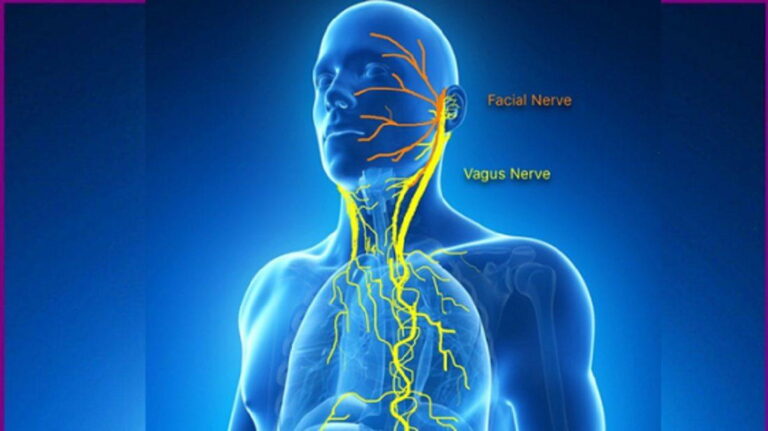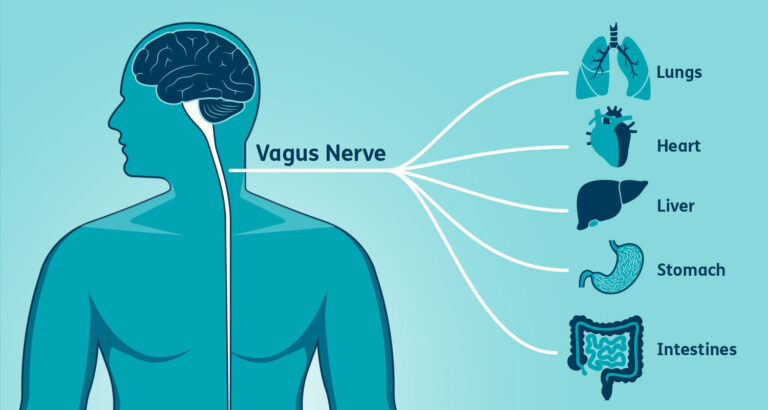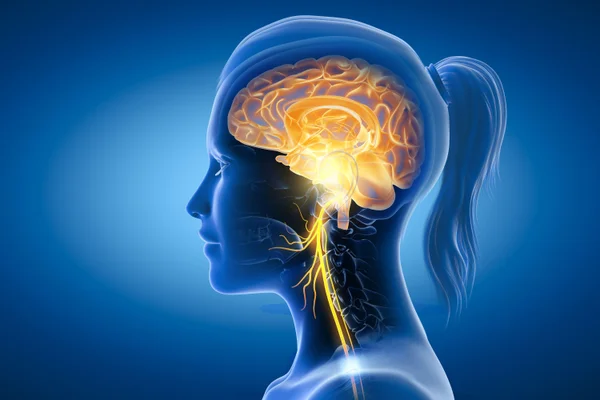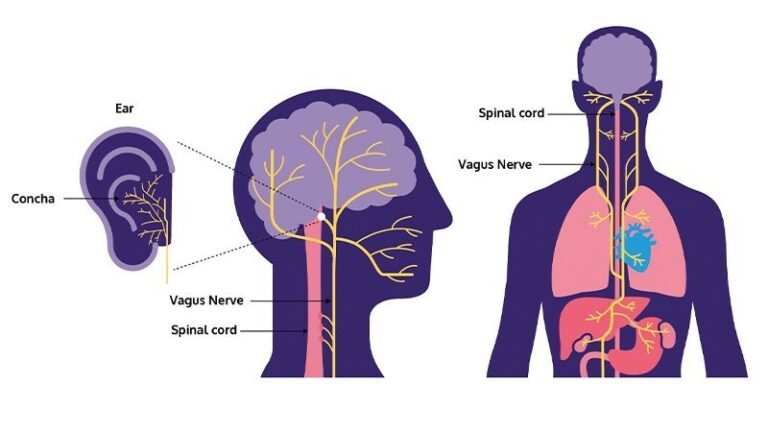Vagus Nerve Exercises For Digestion
What is the Vagus Nerve?
Delving into the intricacies of the human nervous system reveals the vagus nerve, an extraordinary entity that emerges from the brainstem and meanders through the body like a neurological maestro. This extensive neural highway, often referred to as the “wandering nerve,” interlaces with crucial organs, including the heart, lungs, and the intricate web of the digestive system.
Vagus Nerve and Digestion Connection
Unraveling the mystique of the vagus nerve unveils its pivotal role in orchestrating the symphony of digestion. Serving as the primary communicator between the brain and the gastrointestinal realm, this nerve masterfully regulates the autonomic nervous system’s “rest and digest” phase. Its activation triggers a harmonious cascade, culminating in the release of digestive enzymes, heightened gastric motility, and a choreographed dance of nutrient absorption and waste elimination.
Why is it Important to Stimulate the Vagus Nerve?
In the demanding tapestry of contemporary existence, stressors can cast a shadow over the vagus nerve’s intricate dance. The repercussions often manifest as digestive dissonance—bloating, indigestion, and irritable bowel syndrome. Actively engaging the vagus nerve in a dance of stimulation emerges as a strategic maneuver, a pathway to counteract the detrimental effects of chronic stress, and an avenue toward fostering a digestive environment reminiscent of a well-tuned symphony.
How Does Vagus Nerve Stimulation Work?
Unlocking the secrets of vagus nerve stimulation is akin to embarking on a choreographed ballet of exercises. The objective is clear: induce a parasympathetic response, steering the body into a state of relaxation conducive to optimal digestion. At the heart of this stimulation lies acetylcholine, a neurotransmitter that signals the body to embrace the “rest and digest” state.
The repertoire of vagus nerve exercises spans a spectrum that includes deep breathing, humming, gargling, cold exposure, singing, laughter, meditation, mindfulness, yoga, acupuncture, and massage. Each exercise intricately taps into the body’s physiological responses, orchestrating the grandeur of vagus nerve activation and paving the way for a digestive symphony.
Research Behind Vagus Nerve Stimulation
The scientific tapestry supporting the profound impact of vagus nerve stimulation on digestive health is interwoven with a myriad of studies. Robust evidence suggests that activating the vagus nerve enhances gastric motility, amplifies the release of digestive enzymes, and orchestrates a reduction in inflammation within the gastrointestinal tract. These findings underscore the importance of infusing vagus nerve exercises into the fabric of daily life for a holistic approach to well-being.
Vagus Nerve Exercises for Digestion Support
- Deep Breathing: Immerse yourself in the art of slow, diaphragmatic breathing, cultivating a conscious connection with the vagus nerve and igniting a nuanced relaxation response.
- Humming: Infuse your daily routine with the vibrational resonance of humming, allowing the gentle waves to caress the muscles connected to the vagus nerve and fine-tune the digestive symphony.
- Gargling: Dedicate a sacred moment each day to the ancient practice of gargling with cool water, engaging the vagus nerve in a ritual that fortifies the resilience of the digestive system.
- Cold Exposure: Embark on a gradual exploration of cold exposure practices— from the invigorating embrace of cold showers to the awakening touch of facial splashes—awakening the vagus nerve and sculpting the canvas of optimal digestive wellness.
- Singing or Chanting: Immerse yourself in the melodic embrace of singing or chanting, tapping into the synergy of controlled breathing and vocalization as allies in the quest for vagus nerve activation.
- Laughter: Seek out activities that evoke genuine laughter, recognizing it as a natural stimulant for the vagus nerve and a catalyst for elevating the efficiency of digestive processes.
- Meditation and Mindfulness: Immerse yourself in the transformative realms of meditation and mindfulness, cultivating a serene internal landscape that fortifies the vagus nerve and, in turn, digestive resilience.
- Yoga: Delve into the rich tapestry of yoga, exploring poses that intertwine deep breathing and stretching, weaving a narrative of vagus nerve stimulation and digestive rejuvenation.
- Acupuncture: Consider the ancient art of acupuncture, placing trust in a skilled practitioner to navigate the pathways that awaken the vagus nerve and enhance the vitality of digestive processes.
- Massage: Tenderly explore the neck and throat area through the art of massage, unlocking the potential for vagus nerve stimulation and ushering in an era of optimal digestive function.
Integrating Advanced Practices for Vagus Nerve Stimulation and Digestive Euphony
11. Breath Retention Techniques: Explore the transformative world of breath retention, incorporating practices like breath holds after inhalation or exhalation. These techniques deepen the connection with the vagus nerve, promoting a profound relaxation response.
12. Polyvagal Theory Insights: Delve into the Polyvagal Theory, a neurological framework that elucidates the intricate interplay between the autonomic nervous system and social behavior. Understanding this theory can provide additional insights into the nuances of vagus nerve stimulation.
13. Guided Imagery and Visualization: Immerse yourself in the power of guided imagery and visualization exercises. Envisioning scenes of tranquility and well-being can further engage the vagus nerve, contributing to a sense of calm and digestive balance.
14. Biofeedback Training: Consider biofeedback training, a method that enables individuals to monitor and control physiological responses. This approach can provide real-time feedback on vagal tone and guide individuals in enhancing their vagus nerve function.
15. Herbal Support: Incorporate herbal remedies known for their calming effects on the nervous system. Chamomile, lavender, and lemon balm teas are examples of herbs that may complement vagus nerve stimulation practices and promote digestive ease.
16. Progressive Muscle Relaxation (PMR): Engage in progressive muscle relaxation, systematically tensing and then releasing different muscle groups. This not only promotes overall relaxation but can also positively impact the vagus nerve and digestive processes.
17. Grounding Practices: Immerse yourself in grounding exercises, such as walking barefoot on natural surfaces or spending time in nature. Grounding techniques can enhance the mind-body connection and contribute to vagus nerve activation.
18. Alternate Nostril Breathing (Nadi Shodhana): Explore the yogic practice of Nadi Shodhana, or alternate nostril breathing. This technique involves controlled breathing through one nostril at a time, fostering balance in the nervous system and potentially supporting vagus nerve function.
19. Probiotics and Gut Health: Acknowledge the symbiotic relationship between the vagus nerve and gut health. Incorporate probiotic-rich foods and supplements to support a thriving gut microbiome, which, in turn, may positively influence vagus nerve function.
20. Mindful Eating Practices: Cultivate mindful eating habits, savoring each bite and paying attention to the sensory experience of eating. Mindful eating can create a positive feedback loop, enhancing the connection between the brain, vagus nerve, and digestive processes.
21. Aromatherapy:Explore the world of aromatherapy by using calming scents such as lavender, chamomile, or peppermint. Inhaling these essential oils can have a soothing effect on the nervous system, potentially enhancing the impact of vagus nerve stimulation on digestive processes.
22. Cranial Sacral Therapy: Consider cranial sacral therapy, a gentle hands-on approach that focuses on the bones of the head, spine, and sacrum. This modality may help release tension and promote overall relaxation, potentially influencing the vagus nerve.
23. Sound Therapy: Immerse yourself in the therapeutic sounds of singing bowls, tuning forks, or binaural beats. These auditory stimuli can create resonance in the body, positively impacting the vagus nerve and contributing to a harmonious digestive environment.
24. Resonant Frequency Breathing: Explore resonant frequency breathing, a technique that involves breathing at a specific rate to maximize the efficiency of vagus nerve stimulation. Research suggests that finding and practicing your individual resonant frequency may optimize the benefits.
25. Emotional Freedom Techniques (EFT): Integrate EFT, commonly known as tapping, into your routine. This mind-body technique involves tapping on specific acupressure points while addressing emotional concerns. EFT has shown promise in reducing stress and may indirectly support vagus nerve function.
26. Forest Bathing (Shinrin-Yoku): Immerse yourself in the Japanese practice of forest bathing, spending intentional time in a natural environment. Research suggests that this mindful forest experience can positively influence the autonomic nervous system, potentially benefiting the vagus nerve.
27. Resilience Training: Engage in resilience training programs that focus on building psychological resilience. These programs often incorporate mindfulness practices, stress reduction techniques, and positive psychology interventions, all of which can contribute to vagus nerve health.
28. Hydrotherapy: Explore hydrotherapy techniques, including contrasting hot and cold water exposure. Alternating between hot and cold water can stimulate blood circulation and may indirectly impact the vagus nerve, promoting overall well-being.
29. Heart Rate Variability (HRV) Biofeedback: Utilize HRV biofeedback tools to monitor and enhance heart rate variability. Training to increase HRV has been associated with improved vagus nerve function and may offer insights into optimizing your autonomic nervous system.
30. Intermittent Fasting: Consider intermittent fasting as a lifestyle approach. Research suggests that intermittent fasting may positively influence the gut-brain axis, potentially impacting the vagus nerve and supporting digestive health.
As you explore these additional practices, remember that individual responses can vary, and it’s essential to listen to your body. Consulting with healthcare professionals, especially if you have specific health concerns, is crucial. Embrace the diverse array of techniques available, and tailor your approach to create a personalized symphony of well-being that resonates through the intricate dance of the vagus nerve and digestive harmony.
In conclusion, the symbiotic dance between the vagus nerve and digestive well-being beckons us into an exploration of profound interconnectedness. By meticulously incorporating these detailed vagus nerve exercises into the fabric of daily life, we embark on a journey not merely towards digestive health but a nuanced tapestry of vitality. As with any transformative endeavor, the guidance of healthcare professionals is advisable, especially for individuals navigating pre-existing medical conditions. Embrace the nuanced power of vagus nerve stimulation, and unlock the gateway to a symphony of digestive harmony that resonates throughout your entire being.






